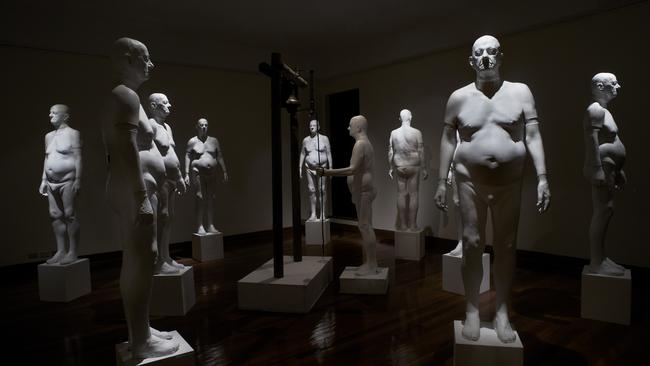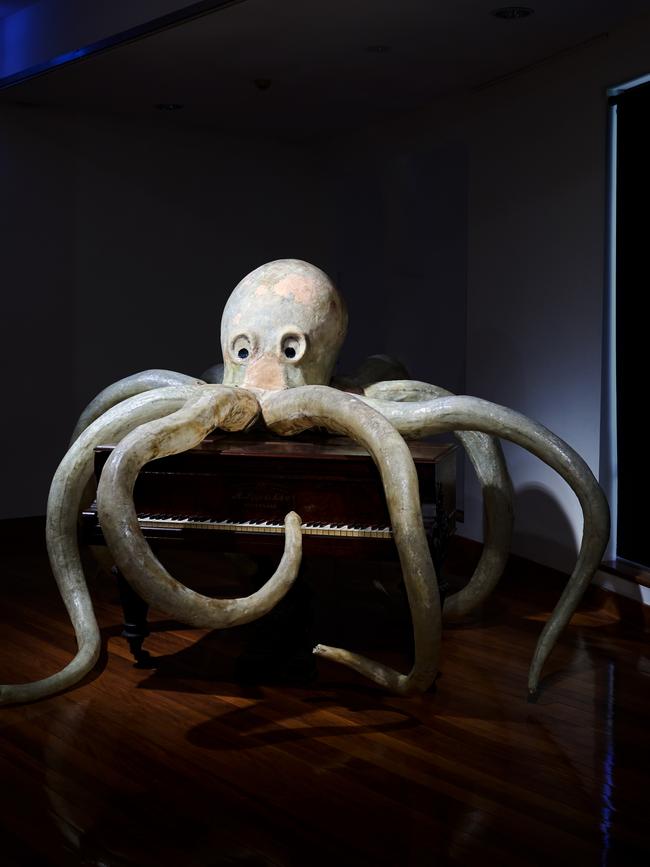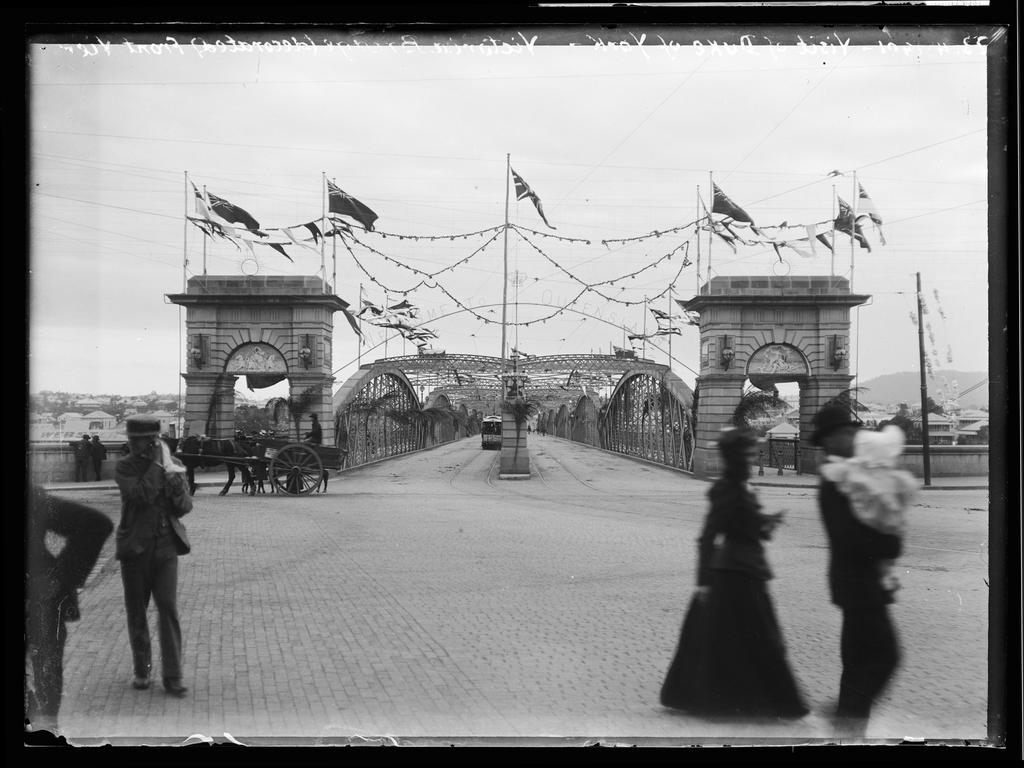Ken Unsworth’s 94 not-out knockout exhibition
Ken Unsworth, 94, is surely one of Australia’s leading artists but does not qualify as being ‘fashionable’ according to today’s standards.

It seems odd that an artist of Ken Unsworth’s seniority and standing – he was described by Daniel Thomas in 2018 as “one of Australia’s leading contemporary artists” – should be showing in such a relatively inaccessible setting as the Macquarie University Art Gallery. When we consider the length of his career, which goes back to the 1970s, and the fact that he is represented in so many of our most important public collections, we might have expected such a survey to be mounted at the Art Gallery of NSW, the National Gallery of Victoria or even at the NGA.
But as friends have suggested off the record, these public galleries - with the possible exception of the Queensland Art Gallery, which has a modest exhibition coming up in July - are not interested in showing the work of an elderly white man like Unsworth, who was born in 1931 and is still practising at the impressive age of 94. The very idea of categorising artists by race is of course obscene, but it has become an ingrained habit in a generation of art apparatchiks. Discrimination by sex is likewise taken for granted, as is, albeit less overtly, discrimination by age.
Because contemporary art is in reality so aligned with money and fashion and lifestyle, there is a distinct preference for young women artists of Indigenous or ethnic background, although extreme age apparently is permissible in Indigenous artists: the large paintings attributed to senior Aboriginal women are highly prized by the art market and in official circles. But identifying as Indigenous, at any age, puts you at the front of the queue for money, awards and exhibitions in today’s Australia.
The focus on identity is inherently socially destructive, encouraging fragmentation and the proliferation of grievance within the body politic, as well as spiralling neurosis at the level of individual psychology. Those who are wealthy and privileged and have nothing much to complain about vicariously share in grievance culture through the highly addictive practices of guilt and self-flagellation. Meanwhile the vast majority of the population take no interest in these issues at all and get on with the more pressing problems of their lives; Asian immigrants in particular are bemused by the self-indulgent moral posturing of the old upper class whom they will one day replace.

In Australia, this self-destructive culture is leading a large part of the sub-intellectual class to view our own history – as I briefly mentioned last week – with a sense of guilt and illegitimacy, and then to inculcate this poisonous ideology in the minds of children at school and young people at university. The implicit corollary of this sort of perspective for art history is effectively to erase the memory of Australian art over almost quarter of a millennium. As I wrote in my early book Art in Australia from Colonisation to Postmodernism (1997), the main theme of Australian art history is the story of settlers coming to terms with the new and strange land in which they had chosen to live: this theme plays out in successive phases from the first colonial painters through the maturation of the high colonial period to the Heidelberg movement and beyond, before being questioned and complicated by modernists like Boyd, Nolan and Drysdale. But the ideologues of so-called “decolonisation” implicitly deny the validity of the experience of these earlier generations, and thus of the art in which it is expressed and articulated.
And this is one of the reasons that our main art galleries are not interested in considering an exhibition by an artist like Ken Unsworth, whose career spans the last half-century. A couple decades ago and even earlier this century, our main galleries would regularly present surveys of historical, modern and living Australian artists. In the last few years, however, and especially since Covid, the interest in Australian art history seems to have collapsed, except for women artists, since all these institutions are desperate to find more women to add to collections inevitably dominated by male artists.
But there is another reason for Unsworth to be ignored by the institutional mafia: his work is imaginative, poetic and even whimsical, but never conceptual or ideological. Most people who claim to teach art in schools and tertiary institutions have little understanding of what it really is, how it works, or why all human societies have produced it in various forms. And the same can be said for most of the people we call curators in contemporary galleries and museums. Once, curators were scholars and experts, often with deep knowledge of art history or a long involvement in the practice of art; now they are simply young people who worked their way through a curatorial course at an art college.

The problem is that they apply a simplistic communication model to the understanding of art. They imagine that art is a matter of conveying a message; so the first thing they suppose an artist does is to decide on his message, and the second is to find an effective way of packaging it, so that it will be efficiently conveyed to its intended recipient. This fallacy is so deeply ingrained that students will automatically write about the “message” in a work by van Gogh or Cezanne in which, needless to say, no such thing exists.
In reality, although some art may be concerned, at some level, with the transmission of already-formulated ideas, its deeper vocation is exploratory, more concerned with thinking and finding than with merely conveying something already determined. Thus Giotto’s frescoes narrate familiar religious stories – and this provides an indispensable structure for them – but his real achievement is in the way he imagines his characters and their feelings, and the physical world of volume and space in which they exist.
Art starts, most intimately, with the handling of materials – with drawing, or painting, or telling stories, or composing music, or modelling clay on the potter’s wheel. It is the love of the practice that leads to greater mastery and refinement, and in that process the artist assimilates the cultural ideas, beliefs and stories of his tradition, and finds new ways to articulate them. Further progress and refinement come with a deeper understanding of art history, of the tradition of the medium, and of theories of practice.
We can see this experiential and imaginative approach, always beginning with feeling and intuition and never with ideology or ready-made “concepts”, throughout Ken Unsworth’s work, whether it is formalistic or quasi-narrative in nature. His very earliest work included sculpture and performance, and the most important of these was a performance limited to a single night but documented on video, Five Secular Settings for Sculpture as a Ritual (1975). Unsworth’s own body became the principal sculptural object in this performance, and a theme which, as we can see from the present exhibition, has continued to preoccupy him ever since.
The video of Five Secular Settings was shown at the Venice Biennale in 1978, where Unsworth represented Australia, together with John Davis and Robert Owen. But equally impressive was another work that revealed a seemingly different, more abstract and at the same time more harmonious aspect of his inspiration: Suspended Stone Circle (1974), in which a collection of large river stones were suspended on taut wires so that they seemed to defy gravity and float in serene stillness. This whole construction had to be supported by steel poles on either side, but in the later version, Suspended Stone Circle II (1974-77, 1988), on display at the Art Gallery of NSW, the stones hang from cables reaching down from the ceiling.

In striking contrast to the serenity of the suspended stones was the wealth of dramatic imagery that Unsworth deployed in the ambitious memorial installation that he produced at Cockatoo Island in 2009, after the death of his beloved French wife Elizabeth (nee Volodarsky), a fine pianist who had turned to teaching French for many years at St Catherine’s School in Sydney, and who died in 2008 at the age of 85. The work was titled A Ringing Glass (Rilke), and was reviewed in this column on Saturday, June 20, 2009. The title was taken from a poem by Rilke in the sequence Sonnets to Orpheus (1923), in which the poet imagines a crystal glass ringing and shattering at the same instant.
The Cockatoo Island exhibition was at once moving and melodramatic, with its grand pianos, sound effects and animations, of which the most impressive was a mechanical skeleton that could have escaped from a grandiose baroque tomb. It is no surprise to find that the Macquarie exhibition, titled Love is the Sweetest Thing and curated by Brad Buckley, continues the artist’s meditation on the same themes of love and loss. Most directly reminiscent of the earlier installation is a room in which a giant skeleton plays a grand piano, or rather a skeleton model of a grand piano, entirely built of little pieces of wood screwed together. Tiny human figures clasp the piano or seem to want to climb up on it, ithyphallic like the skeleton, vain images of desire and longing.

More enigmatic is another installation in which a huge fibreglass octopus sits on top of an antique grand piano and touches the keyboard with one of its tentacles; this piece is an interesting example of the way Unsworth has often used the grotesque or even kitsch to evoke unexpected feeling – here perhaps of the obsessive quality of memory. Nearby is another piece – the reworking of a theme used earlier – in which a figure that is a cast of the artist’s own body carries an enormous cage of doves on his back; it is a work full of paradoxes, for the cage is very big but largely consists of empty space, and the birds it imprisons are also symbols of freedom and peace.
Unsworth’s use of his own body in this sculpture or installation recalls his role as performer in Five Secular Settings, exactly half a century ago: it is the same almost naked body, only now of course much older. And the artist’s figure is the basis for the last work in this show, in which it has multiplied into a group of silent white bodies, with closed eyes, standing together on little plinths in a circle, some turned inwards and some outwards.
In the centre, one of them stands in front of a bell suspended on a wooden frame and holding the bell cord in his hand. There is a little pedal on the floor, which invites the visitor to press it. When we do, nothing happens for a moment, and then – even more disconcertingly than if the reaction had been instantaneous – all the figures begin to shake violently. The work is titled Memory, and in its characteristically slightly awkward way it is a moving evocation of the sporadic and unexpected return of the memory of grief.
Ken Unsworth: love is the sweetest thing, Macquarie University Art Gallery, until May 21.







To join the conversation, please log in. Don't have an account? Register
Join the conversation, you are commenting as Logout